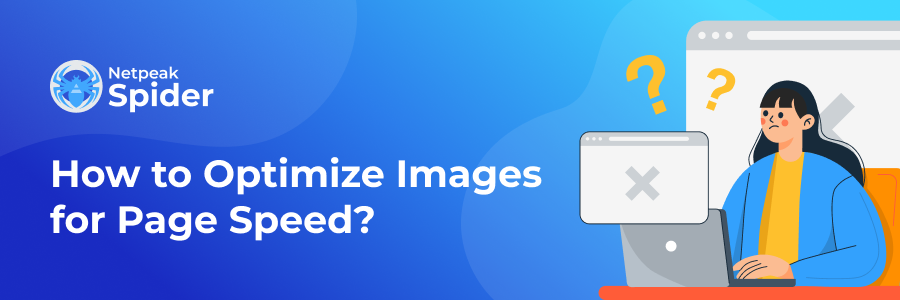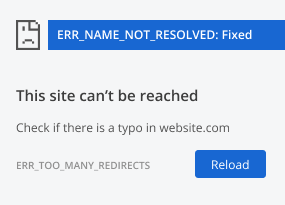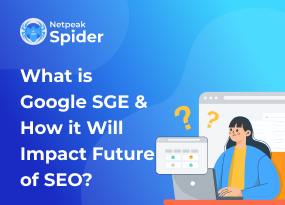How to Make Images Load Faster on Website — Top Tips
Site Audit Issues
How does image optimization work? What's the best image format for website speed? How to load images faster on website? Find answers to these and other questions in this article. We'll cover all the basics you need to know about page speed optimization and how Netpeak Spider can help you with that.
What is image optimization and how it affects page load speed
In web publishing, it's crucial to optimize page speed, and image optimization is an inalienable part of it. This process basically means delivering high-quality visuals in the right size, format, resolution, and dimension while reducing their file size without spoiling the image quality. What's even more important is that you need to make sure these images won't slow down the page load time of your website.
Images can seriously impact the website speed. Larger image files not only slow down your site but also result in poor UX and lower search engine rankings.
How to define page speed
Page speed shows how long it takes the content on your web page to load. In other words, it's the amount of time a browser needs to receive the first byte of data from a server.
Page speed impacts website's overall performance, user experience and satisfaction, engagement, and conversion rates. Even slight delays may bring negative consequences and compromise user trust in your site. And it's not just about user frustration — Google also considers page load speed when determining its position in search results, meaning your website becomes less visible to potential visitors and customers.
Most SEO tools measure page load speed on a scale from 0 to 100 and provide useful tips on improving it. A fast page gets a score of 90 or above, a score of 50 to 90 is average, and a speed score below 50 is considered low.
Factors impacting page load speed
Below is a list of factors that most likely will affect Google page speed optimization:
- Bulky code
- Too many redirects
- Server response time
- Uncompressed content
- Excessive HTTP requests
- Heavy, unoptimized images
From this list, images usually slow down the page load speed the most. At first sight, large, high-resolution visuals seem more attractive, but at the same time, they significantly increase the page load time, causing lots of inconvenience to site visitors.
Is there a correlation between image and page speed?
So, how can images affect the webpage's load speed? The answer lies in the process of loading a web page since the browser has to download all the on-page resources, including images, once you enter it.
Big, hi-res images contain more data and thus will take longer to download, especially on mobile devices. The number of images on a page also plays a role, and the more images are there, the later it'll fully load.
Here are some of the major factors that can result in image-related page speed problems:
- Image formats (JPEG, PNG, or GIF);
- Uploading images without compression
- Server's performance
- Using too many visuals
Benefits of optimizing images
Now that you know how essential image optimization is for your website's overall load speed, let's see what benefits it brings if appropriately implemented:
1. Better UX. Well-optimized, fast-loading visuals improve the UX by keeping visitors constantly engaged. Considering that search algorithms prioritize user-friendly websites, you can significantly boost your SEO rankings.
2. Higher PageSpeed Insights Score. For Google's PageSpeed Insights, the loading speed of an image is critical in improving the page's overall load speed. Optimizing images gives your website a higher score, thus resulting in better SERP rankings.
3. Decreased Bounce Rate. Images that take a while to load can increase bounce rates because users tend to leave pages that don't load fast.
4. Enhanced Mobile Optimization. Fast-loading visuals contribute to mobile optimization, which has become an essential aspect since Google's transition to mobile-first indexing. This boosts your website's visibility and improves its search engine ranking.
How Does Google Interpret Slow Loading Images
According to Google, both image and page speed are essential for creating an excellent user experience. Hence, when your website is slow to load, it causes frustration among users, making them leave your site and increasing the website's bounce rate. Google will interpret this as a sign that your site isn't valuable or convenient enough, consequently lowering your SERP rank.
Tools to detect image-related issues on your site
So, how can you track image-related threats on your website? Below, you'll see some of the most effective tools you can try to fix image optimization issues on your website.
Free tools for image optimization
Paid tools for image optimization
How to optimize images and improve the page speed
So, how do you improve Google page speed optimization? Below is the list of main recommendations that can help you out.
Image compression and format
Compression is critical for optimizing page speed. As you compress an image, you reduce the image file size without compromising its quality. Many modern services implement advanced algorithms to compress images with zero quality loss more efficiently.
Choosing the appropriate file format also plays a role here. The best image format for website speed would be JPEG for photographs and PNG for images with transparency. Using these formats will noticeably increase page loading speed and the overall user experience.
Responsive image sizing
Another way to improve page speed optimization is to tailor image dimensions to the requirements distinctive for each device and screen resolution. To handle this, use responsive image attributes in HTML "srcset" — the attribute takes into account the device you're using and adjusts image sizes based on that.
Lazy loading
Lazy loading lets you delay loading images until the user reaches the very section where the image is placed. To enable that, implement the "loading" attribute in the HTML image tag. Alternatively, you can incorporate JavaScript libraries — e.g., LazyLoad.js. Thanks to lazy loading, you reduce initial page loading time and boost your website's performance.
Efficient image setup via content delivery networks (CDNs)
A CDN is a network of servers located in various parts of the world. These networks distribute images across servers worldwide, thus letting users access them via the server located the closest to them. This way, CDNs minimize latency, decrease image load time, result in lower bounce rates, and increase on-site time.
Image caching
When you cache an image, you practically store its copies on your device after the initial visit. Caching helps reduce the load on a server to download the images again when you're revisiting the same page.
What to avoid when optimizing images
There are several mistakes you might make while trying to optimize page speed. Make sure to avoid doing the following:
1. Using high-resolution images without resizing or compressing them.
2. Not adding alt tags to your images, which affects both the SEO & accessibility of a given page. Moreover, the alt tags should always be descriptive and contain relevant organic keywords.
3. Not limiting the number of images allowed on a target page.
4. Neglecting image optimization for mobile devices.
How to ensure image optimization with Netpeak Spider
Now that you know how to load images faster on website, let's look at how to prevent image optimization issues in the future. Netpeak Spider will definitely come in handy here.
This is a multifunctional research tool for SEO experts and website owners that analyzes over 100 different parameters, including the ones related to page speed. Thanks to third-party app integrations, you can quickly retrieve data from Google Analytics and Search Console to enrich your research data.
Moreover, it's pretty simple to work with Netpeak Spider. Suppose you need to check your own or competitor's website for image optimization. In that case, you'll only need to enter the target URL(s) into a search bar, select the Images parameter in the settings, and click on the Start button.
In a few moments, you'll receive a detailed report on every target page you've added and a list of warnings and troubleshooting tips for each issue the tool has encountered.
Bottom Line
Image optimization is vital to ensuring a high web page loading speed. Well-optimized images ensure greater user experience and higher search engine ranking of your page or an entire website. Hence, taking care of Google page speed optimization should become your SEO checkup routine.
Try Netpeak Spider to help you with that — you'll not only automize this process and spare time for other tasks but also make sure to avoid potential image-related threats in the future. Get the app today and start boosting your website performance right away!


.png)
